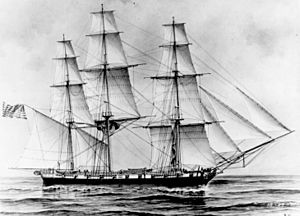USS Erie (1813) facts for kids
 |
|
Quick facts for kids History |
|
|---|---|
| Name | USS Erie |
| Builder | Thomas Kemp, Baltimore, Maryland |
| Cost | $25,461.05 |
| Launched | 3 November 1813 |
| Fate | sold, 26 November 1850 |
| General characteristics | |
| Tons burthen | 509 tons |
| Length | 117 ft 11 in (35.94 m) |
| Beam | 31 ft 6 in (9.60 m) |
| Depth of hold | 14 ft 6 in (4.42 m) |
| Complement | 140 officers and enlisted |
| Armament |
|
The USS Erie was a special kind of warship called a sloop-of-war. It had three masts and a wooden body. This ship was an important part of the United States Navy in the early 1800s. It helped protect American interests around the world.
Contents
Building and First Sail
The Erie was built by Thomas Kemp in Baltimore, Maryland. It was launched into the water on November 3, 1813. The ship first sailed on March 20, 1814, with Commander Charles G. Ridgeley in charge.
However, the British Navy was blocking the sea near Hampton Roads. This meant the Erie could not get out to the open ocean. So, it had to go back to Baltimore on April 7, 1814. The ship stayed in Baltimore without a crew until early 1815.
Protecting Trade in the Mediterranean Sea
On May 8, 1815, the Erie sailed to Boston, Massachusetts. There, it joined Commodore William Bainbridge's group of ships. They set sail for the Mediterranean Sea on July 2. Their mission was to deal with Algiers, a country that was causing trouble for American ships.
Luckily, peace was made with Algiers before the ships even arrived. So, the group of ships returned to the United States. But the Erie stayed behind. Its job was to cruise the Mediterranean. It helped protect American trade ships and made sure the peace with the Barbary States lasted.
The Erie stayed on this important mission for four years. It finally left Gibraltar to go home on November 27, 1819. After stopping in Madeira and the West Indies, it reached New York on January 20, 1820. The ship then spent three and a half years getting repaired.
Upgrades and More Mediterranean Trips
During its repairs, the Erie was made longer. It grew to 122 feet (37 m) and its weight increased to 611 tons. This made it a bigger and stronger ship.
In November 1823, the Erie sailed from New York again. It went back to the Mediterranean Sea and served there until 1826. From 1827 to 1832, the ship was based in Pensacola, Florida. It would travel north to New York or Norfolk, Virginia for any needed repairs.
The Erie also patrolled in the West Indies and near the coast of Mexico. Its tasks included protecting American citizens and their belongings. It also helped stop the illegal slave trade and guided merchant ships safely.
Service in South America
From August 21, 1832, to June 24, 1834, the Erie was kept in storage in Boston. This means it was not actively sailing.
After this, the ship served on the Brazil Station for three years. For the last two years, it was the flagship. This means it was the main ship in the group, carrying the commander. During this time, there were many changes and problems in countries like Brazil, Uruguay, and Argentina. The Erie and its group of ships protected Americans and their businesses. They also gathered important information about these countries.
The Erie was again stored in Boston from September 15, 1837, to February 4, 1838. On February 9, it sailed along the Atlantic coast. Its new job was to help any merchant ships that were in trouble. In July, it sailed to Pensacola. For two weeks, it patrolled the West Indies and the Gulf of Mexico. This was to protect American interests during a time when France was blocking Mexican ports.
Missions in the Pacific Ocean
Between July 1840 and February 1843, the Erie was rebuilt in Boston. It was changed into an armed storeship. This meant it could carry supplies for other ships, but it also had weapons to defend itself.
On February 9, it sailed for the Pacific Ocean. On its way, it delivered supplies to ships on the Brazil Station. It reached Callao, Peru, on July 27. The Erie then sailed to the Hawaiian Islands and Society Islands between November 1843 and January 1844. During this trip, it served as a flagship again. In June 1844, it sailed back to New York, arriving on November 10.
The Erie then crossed the Atlantic to deliver supplies to the African Squadron. This was a group of ships in Africa. After repairs in New York, it returned to the Pacific Squadron on November 18, 1845.
When the Mexican–American War started, the Erie was in the Hawaiian Islands. But it quickly returned to the coasts of Mexico, California, and Panama in August 1846. Its job was to bring supplies to the fleet during their sea operations and landings. It helped in the capture of Mazatlán on November 11, 1847. Soon after, it sailed for the east coast, reaching New York on June 24, 1848.
Final Journeys
The Erie set sail for the coast of Africa and the Mediterranean on September 15, 1848. Its mission was to deliver supplies to ships in those areas. It returned to New York on July 11, 1849. Between September 6, 1849, and September 12, 1850, it made two more trips to the Mediterranean with supplies.
The USS Erie was finally sold in New York on November 26, 1850.

